France
The most well known bliaut examples are seen on the statues at Chartres in France. These bliauts drape in knife-like pleats that suggest they are made of silk. The floor length sleeves start to widen into a long triangle at the elbow. Some have deeply slit V-shaped necklines that come close to the neck on the sides. Both men and women wear floor length bliaut. Many bliauts include a double wrapped belt.
|

|

|

|
Chartres: See the knife-pleats and the long sleeves with geometric trim on the edges. Notice that her sleeves are square at the bottom.
Provins, St. Thibaut, 1160-70 (Glencairn Museum, Pitcairn Collection, Bryn Athyn, PA): See the deeply slit V-neck.
Chartres, Royal Portal Left Side figure 3: See the long belt with the tassles all the way down past her knees. If you look at her upper abdomen, you can see a wrap of the belt. At her lower abdomen, you can see the belt come together again and tie. Again her sleeves are square at the bottom.
Cathedral Basilica of St-Denis, Paris, 1145-50 (Metroplotian museum of art - cloisters): See the squared, deep slit-neckline and the long wrapped belt with tassles.
England
Men's bliauts in English art are mostly knee length. Neither gender has the double wrapped belt of the French. The sleeves vary from floor length to knee length on women and tight sleeves or bell sleeves on men. Neck lines are round or keyhole. The sides are tight waisted. The knife-pleats which suggest silk are also evident here.
| 
| 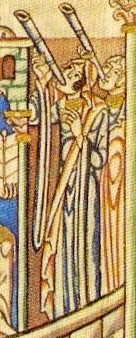
|
De Consolatione Philosophiae, c. 1130-40 West Country Oxford, Bodleian Library, MS Auct. F. 6.5.g, late 12th Century: See her floor length yellow trimmed sleeves on a green bliaut. The sleeve shape is clearly evident on the musicians to the right where they widen at the wrist in a long thin drape. His sleeves appear to widen high up the arm but are not long. He is wearing a wide belt and his bliaut is floor length.
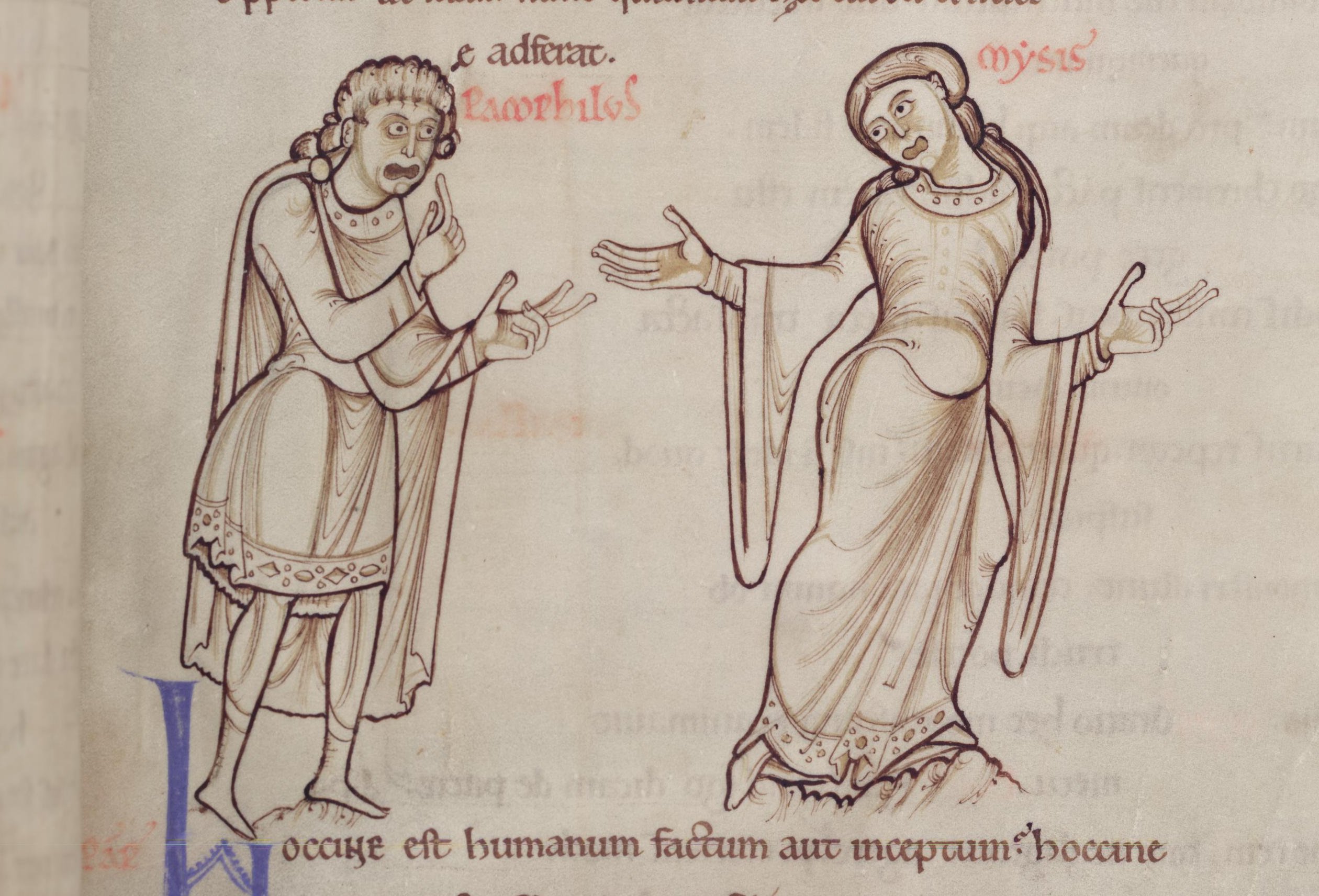
Terence's Comedies, St. Albans Abbey, mid 12th century, Folio 10 recto: See her knee length sleeves, tight waist, and round neckline. She is not wearing a belt. Notice that his bliaut is tight waisted but only knee length. It has tight sleeves. Her sleeves begin to widen above the elbow and come to points at the bottom in contrast to the square french sleeves. Both have geometric trim at the neckline and hem.
|
|
St. Albans Psalter, ca. 1119-1146, The Mocking of Christ, pg 43: See the knee length bliauts on the two men surrounding Christ. Notice the trim at neck, wrist, and hem. The keyhole necklines extends to the waist. Copyright Dombibliothek Hildesheim.
St. Albans Psalter, ca. 1119-1146, The Visitation, pg 20: Notice the trim at wrist and hem and the matching belt on the two servants to the right and left sides. Copyright Dombibliothek Hildesheim
Italy
The sleeves seen on Italian women vary between rectangular floor length sleeves which begin to widen close to the wrist to the triangular sleeves seen in England and France. The women are wearing caps similar to those seen in Ghirlandaio paintings 200 years later. The knife-pleats which suggest silk are also evident here.
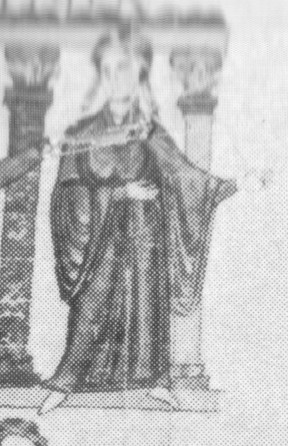
|
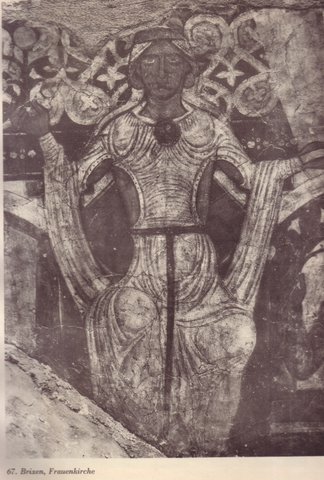
|
Bible of Santa Maria del Fiore, Tuscany (Bibl. Laurenziana, Edili 125 for volume 1 and Bibl. Laurenziana, Edili 126 for volume 2, located in Florence), start of the 12th Century: Her sleeves are knee length with more rounded tips than we saw in the French and English artwork. The sleeves begin to widen above the elbow.
Our Lady of Bressanone, from a chapel on the Italian/Austrian border called "Bressanone" in Italian and "Brixen" in German - about 50 miles south of Innsbruck, dated to 1214: See the open unlaced sides and arms. This may be the only example of laced upper arms on a bliaut. Her sleeves clearly begin to widen below the elbow. Her belt circles her waist once and has a long front tail.
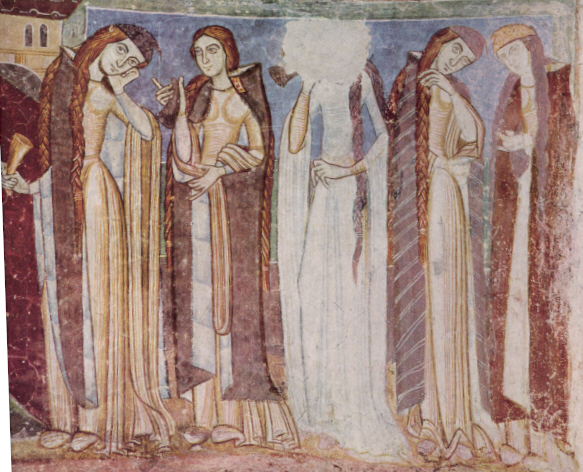
A frecso dipicting the story of "the foolish virgins" from Castel d'Appiano in Trentino Alto Adige, Italy: See the long flowing sleeves and the tight waists.
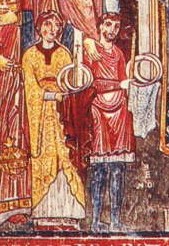
|
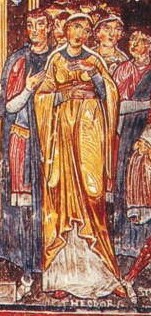
|
A fresco from the Church of S. Clemente in Rome, 12th Century: The man on the left side has a knee length bliaut with no visible belt but his undertunic is showing at the knees. He has a high round neckline and long sleeves. The woman on the left has a keyhole neckline, a belt high enough to be empire waisted and knee length pointed sleeves which begin to widen above the elbow. The right woman's bliaut also has an empire-waisted belt. Her head covering is either a cap or a veil tied behind her neck.
Germany
In general, these bliauts are loose at the waist and belted with a normal belt. The sleeves begin to widen close to the wrist. Here, the bunched folds of fabric suggest linen or wool rather than silk.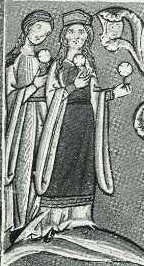
| 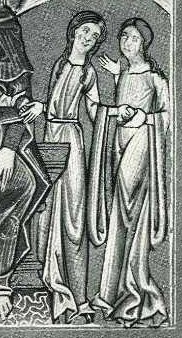
|

|
Psalter of Landgraf Hermann von Thuering 1217 "Paradise: Lazarus in Abrahams lap distributes the fruits of the eternal life.", Vorgotische pg 77: See the longer-than knee-length sleeves that begin to widen very close to the wrist. They are rectangular in shape rather than triangular. Notice that the gowns are loose at the waist and belted. Also notice the sleeveless overcoat worn by the women on the left. The women all have braided un-veiled hair.
The Stammheim Missal fol. 11v:, The Annunciation: See the knee length sleeves, loose waist, and veil of the women.
Early 13th C. Lamenting mothers of Bethlehem, Vorgotische pg 69: See the extremely long slits in the keyhole necklines. It has been suggested that this is nursing garb but no children are seen here. Notice that the sleeves again begin to widen close to the wrist and are very long. These gowns are loose waisted and belted. Their hair is mostly loose and un-veiled.
End of the 12th century, Vorgotische pg 67: Notice that the long sleeves of the person are tied behind his/her neck. The hair covering looks more like a man's coif than a women's veil.
Switzerland
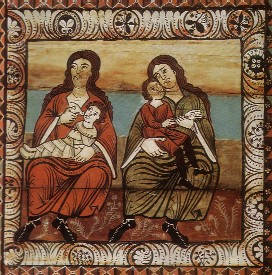
|
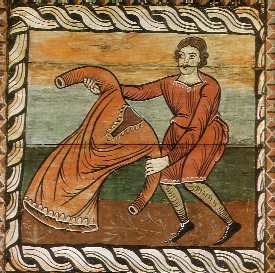
|
St. Martin Church in Zillis Switzerland: See the relatively short triangular sleeves. They appear to be lined. The women's hair is worn loose.
St. Martin Church in Zillis Switzerland: He clearly has a keyhole neckline and a knee length garment with tight sleeves. Side lacing is not apparent.
Poland
The sleeves begin to widen just after the elbow. Both tiny and floor length sleeves are seen. The waist is loose and unbelted.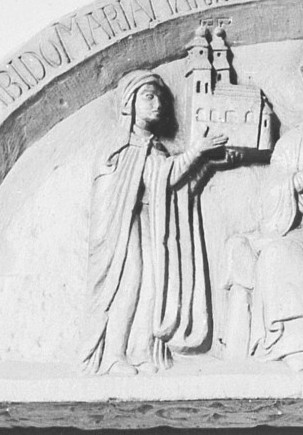
|
A Tympanium from Breslau, ca. 1200: Note the long sleeves.
The Adoration of the Lamb, Cammin, 13th C: Note the tiny bell sleeves. |
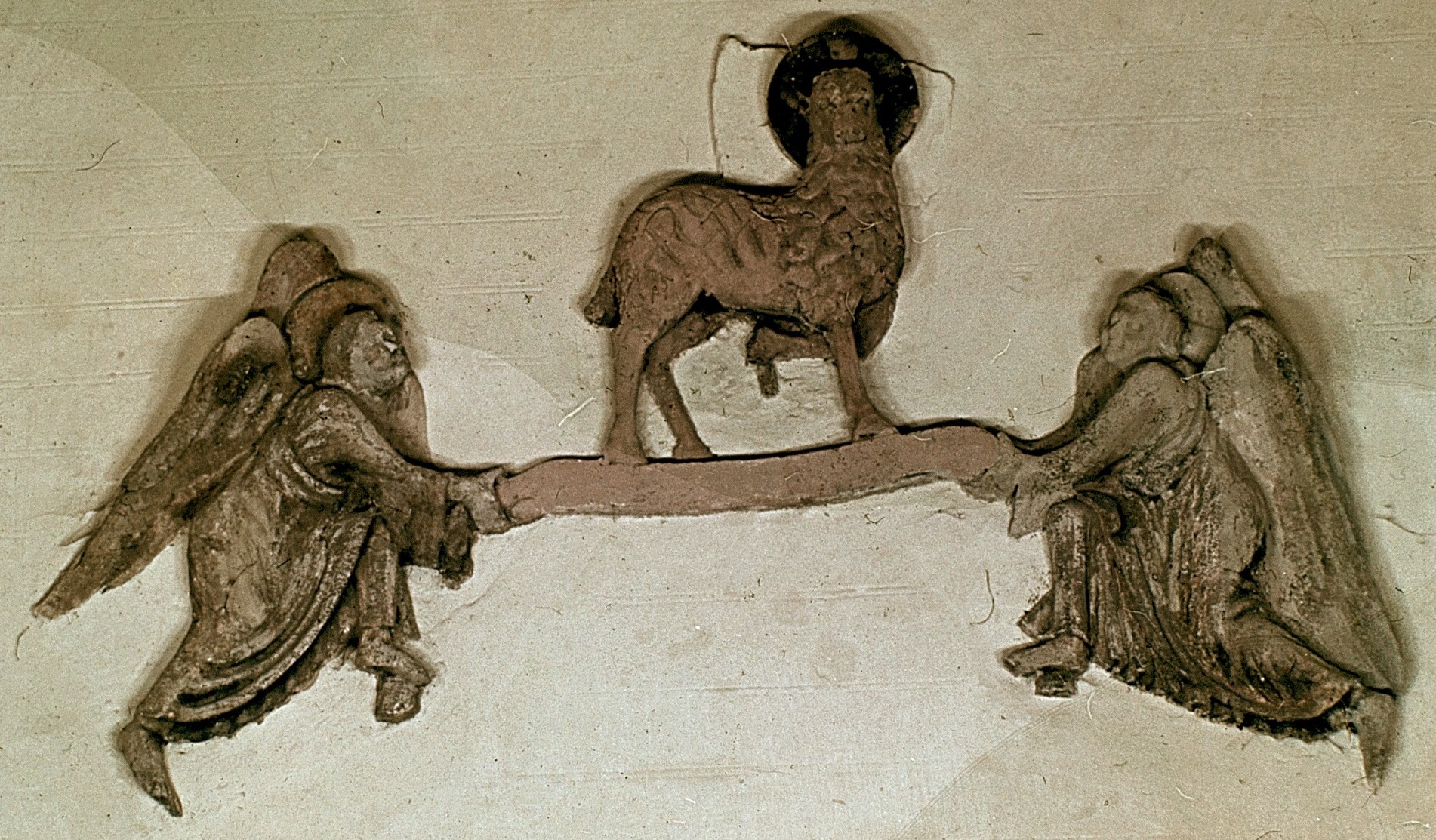
|
|
Sweden
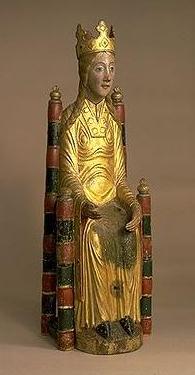
Madonna of Viklau, Church of Viklau: See the knee length sleeves and the V-slit neckline.
Construction Theories
These are all theories on what causes the horizontal wrinkles at the waist, the vertical wrinkles below the waist, and the vertical wrinkles around the neck.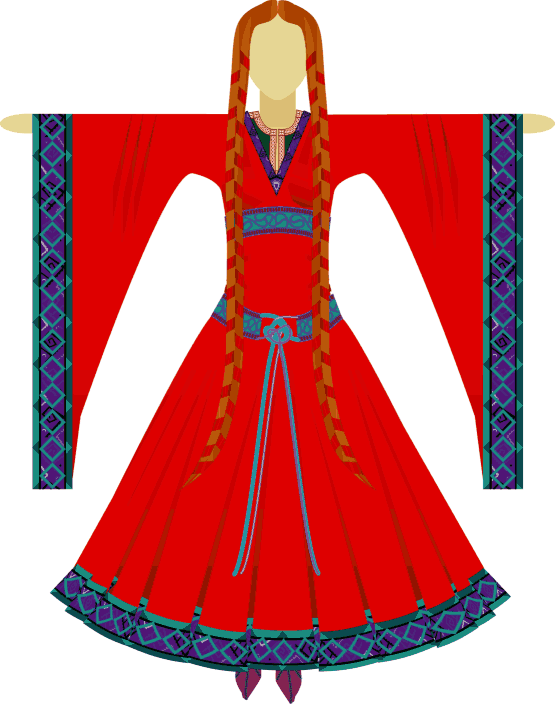
|
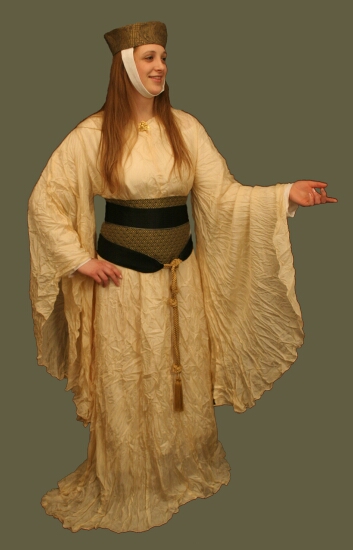
|
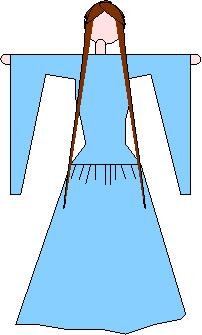
|
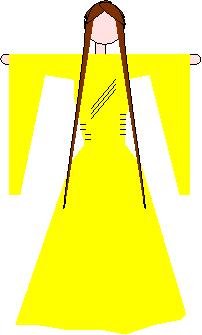
|
Drawing by Marguerie de Jauncourt. Side laced with a wrapped belt. Horizontal wrinkles come from tight lacing at the sides.
Revival Clothing (space #100, Street of Gold, Pennsic 2009). Loose with a stomacher to tighten the waist and a wrapped belt over it. Although many costumers like this look, the stomacher theory is no longer believed to be correct.
Drawing by Aibell ingen Dairmata. Pleated skirt sewn onto seperate torso. I have tried this contruction technique and found that it completely lacked the horizontal wrinkles. This theory is now generally considered to be incorrect.
Drawing by Aibell ingen Dairmata. Bias cut and side laced to let the middle stretch creating the horizontal wrinkles. The main body of this garment is cut on the bias (diagonally on your fabric) which causes wasted fabric. Since fabric was too expensive to waste, I believe they would not have used this method.
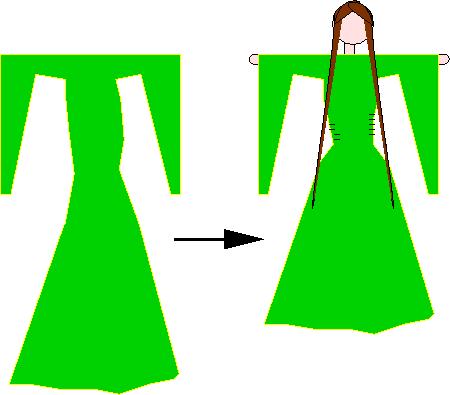
|
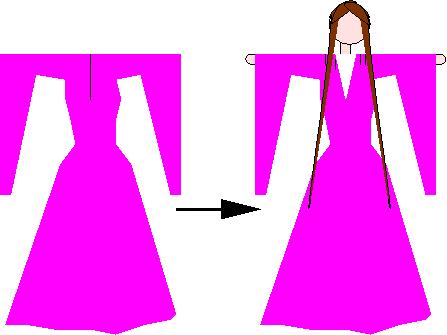
|
Drawing by Aibell ingen Dairmata. Waist is longer (not wider) than usual and side laced to create the horizontal wrinkles. I personally support this theory.
Drawing by Aibell ingen Dairmata. Neck is cut as a slit rather than a neck hole to create the vertical wrinkles around the neck as seen in some French artwork. I personally support this theory. (Note: Some bliauts come with an obvious round or keyhole neckline and no wrinkles).
I believe that the numerous vertical wrinkles seen on the lower parts of the gowns and on the sleeves are caused
by the usage of fine
silk which can form knife-pleats. Some of the German gowns clearly show softer folds which can
result from using soft wool. Other gowns show sparser sharp pleats which can result from using linen.


























